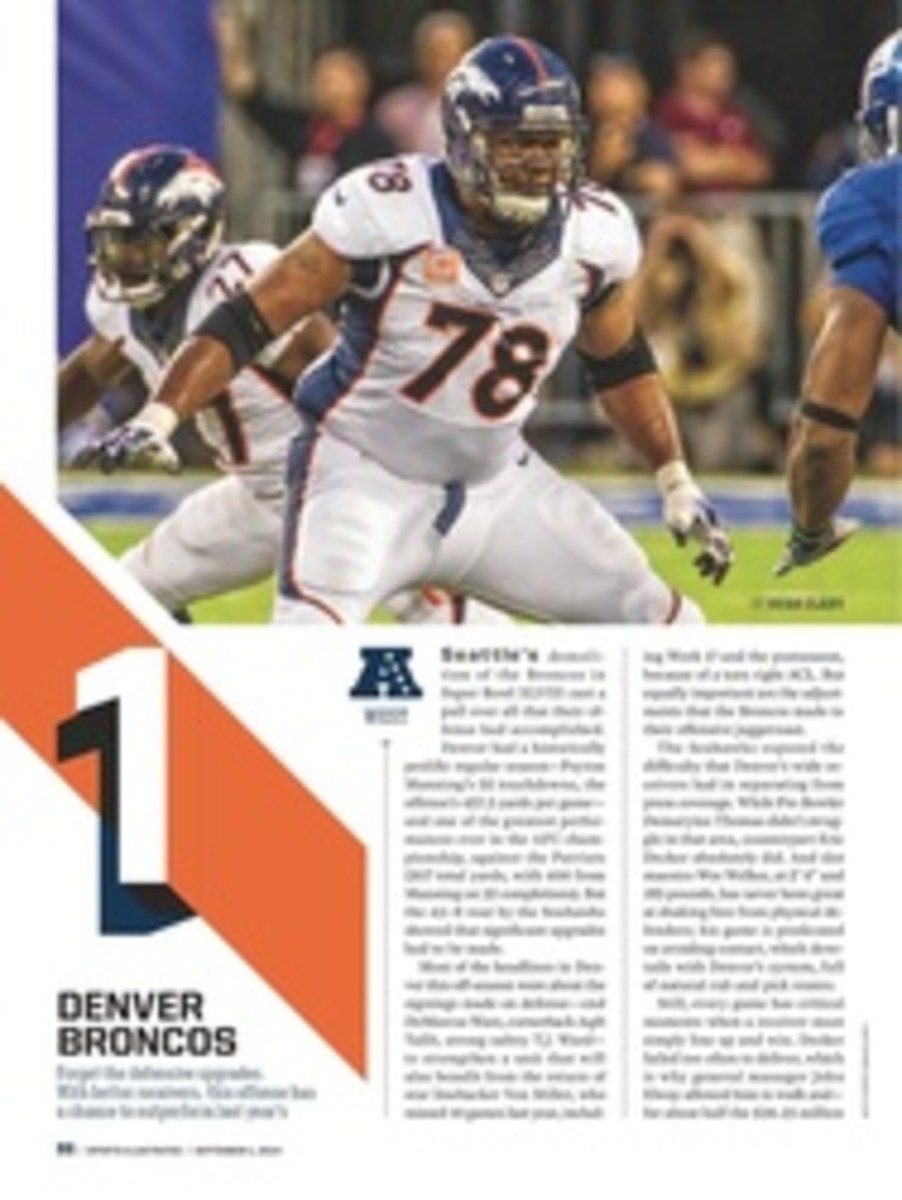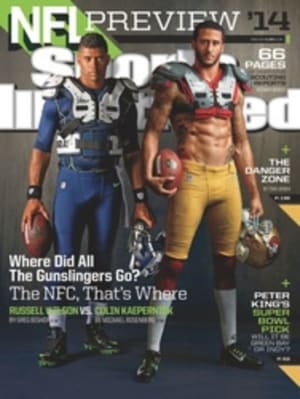
4 ST. LOUIS RAMS
With the second pick of the 2014 draft, St. Louis selected tackle Greg Robinson, the most physically imposing offensive lineman to enter the league since Leonard Davis in '01. The choice makes perfect sense when you consider the way the Rams played over the final three quarters of '13. After their new spread offense gained no traction early on, coordinator Brian Schottenheimer committed to a straightforward between-the-tackles rushing attack down the stretch. Sam Bradford's torn left ACL in Week 7 cemented that approach.
It will remain the Rams' foundation in 2014. Even before Bradford retore his ACL last Saturday in St. Louis's third preseason game, coach Jeff Fisher and his staff decided that a ball-control offense best suited their personnel. That could explain why the team drafted Robinson (Auburn) to play alongside veteran linemen Jake Long and Rodger Saffold (two formidable run blockers who suffered notable injuries last year) and why, aside from third-round pick Tre Mason (also Auburn), they made no significant changes to a backfield that features Zac Stacy, a fifth-round pick in '13.
With Shaun Hill tabbed as the interim signal-caller, this is an offense that will be asked simply not to lose games. Typically, that's not enough in today's era of wide-open football. But when you're shorthanded on offense and have a dynamic, playmaking unit on the other side of the ball, it's the best (if only) approach. That defense, which will be coordinated by Fisher's longtime confidant, Gregg Williams (two years removed from a bounty scandal), boasts what is unmistakably the best front four in the NFL. That starts with end Robert Quinn, who has already established himself as far and away football's quickest, most supple—and therefore most feared—edge force. Williams loves to blitz, but with Quinn and a nickel D-line that's made up of deserving first-rounders, he won't have to.
Because Quinn commands double teams outside and can dominate inside (as a tackle, stand-up joker or however else Williams might use him), the Rams' arsenal of twist and stunt pass-rushing concepts is nearly unstoppable. Executing those, often against one-on-one blockers, will be sturdy end Chris Long, strong-handed tackle Michael Brockers and, on passing downs, quick-twitch rookie Aaron Donald (Pittsburgh). Likely starting ahead of Donald in the base 4--3 will be Kendall Langford, who has deft mechanics and impressive movement skills lining up in a multitude of spots. Providing high-quality depth is Eugene Sims, as well as seventh-year veteran William Hayes. Both are versatile and good lateral movers, which is crucial because Williams will feature a variety of personnel groupings and alignments here.
The back end is where it gets tricky. With a potent four-man rush, Williams will focus much of his creative energy on his back seven, where players will have to excel in coverage exchanges, rotations and disguises. This is challenging enough for a veteran unit, never mind one as young as St. Louis's. The most gifted physical specimen in that group, 2013 first-round pick Alec Ogletree, will be key. But while Williams won't find a better movable chess piece, Ogletree's awareness at this point could limit him to being just a pawn.
In the secondary, risk-taking corners Janoris Jenkins and Trumaine Johnson (who'll likely miss the first quarter of the season with a sprained left MCL) are entering their third seasons, and nickelback Lamarcus Joyner is a second-round rookie. Joyner is another movable piece, given his experience playing the slot and safety at Florida State. The safety he'd replace in a base 4--3 is third-year pro Rodney McLeod. Even younger than McLeod is lanky strong safety T.J. McDonald, who covers plenty of ground but who must develop more dimension.
That's a ton of inexperience, but a young secondary is the type of weakness that can be offset by an explosive pass rush. With opposing QBs being rushed into quick throws, there will be plenty of plant-and-drive opportunities for this aggressive group of ball hawks—especially the corners. In many pressure-based D's, corners don't have big-play opportunities because the ball is coming out quickly only by the force of a blitz. And when blitzing, it's often mandatory to play press-man coverage so as to disrupt the receiver's timing early in the route and also to account for the fact that there are fewer defenders left on the back end. This nullifies most zone concepts. But that's not the case in St. Louis. A malleable, electric four-man rush leaves plenty of bodies in coverage and more room for gambling.
With the offense just trying to control games, mostly in three-to-six-yard chunks, the defensive side is where the Rams' gambling will happen this season.
2014 SCHEDULE
2013 Record: 7--9
WEEK 1
MIN [HOME]
TB [AWAY]
DAL [HOME]
BYE
PHI [AWAY]
SF MON [HOME]
SEA [HOME]
KC [AWAY]
SF [AWAY]
ARI [AWAY]
DEN [HOME]
SD [AWAY]
OAK [HOME]
WAS [AWAY]
ARI THUR [HOME]
NYG [HOME]
SEA [AWAY]
WEEK 17
CAUSE FOR CONCERN
The wide receivers
When you employ basic two-back or two-tight-end formations and run a ball-control offense, as the Rams do, your wide receivers must be able to separate off the line on the outside. The diminutive Tavon Austin is not the only Rams receiver who struggles here. Chris Givens, a downfield speedster, is an unpolished route runner, which is why he's fallen behind last year's third-round pick, Stedman Bailey, and 2012 second-rounder Brian Quick on the depth chart. Bailey remains somewhat of a mystery at the NFL level; Quick must learn to play with better body compactness in order to explode downfield. Also contending for reps is Austin Pettis, a fairly ordinary possession target. And then there's Kenny Britt, the biggest surprise of training camp. The free-agent pickup showed the type of burst that once made him a promising star under Jeff Fisher in Tennessee. (Britt had nine TDs in '10, their last year together.) Injuries and immaturity all but derailed Britt over the last three seasons, but if he can stay on the field, he could be the only Rams receiver capable of consistently separating off the line.
THE CASE FOR
Receiver Tavon Austin
At 5'8", 176 pounds, Austin, we've learned, simply can't flourish in the NFL if he has to come off the line of scrimmage in traditional wide receiver fashion; it's too much of a challenge for him to consistently beat press coverage. If the Rams want to get any value out of their multipick, first-round investment from 2013, they must revisit some of the spread concepts they installed heading into last season. Austin is lethal in space, but the play designs must help afford him that space. Besides putting him in motion and out of the slot, another way to create space is by bringing Austin out of the backfield. This gives him even more initial room to work with and almost always gets him matched up against a linebacker or a safety. (The Eagles found success doing this last year, for example, with DeSean Jackson.) From the backfield Austin can take toss sweeps and reverses or catch swing passes. The idea: Get him the ball in a way that makes the play's structure more like that of a punt return. Even threatening to use Austin in this way is enough to worry a defense.
PHOTO
OTTO GREULE JR/GETTY IMAGES
DE ROBERT QUINN
PHOTO
MICHAEL CONROY/AP
NINTEEN PHOTOS

